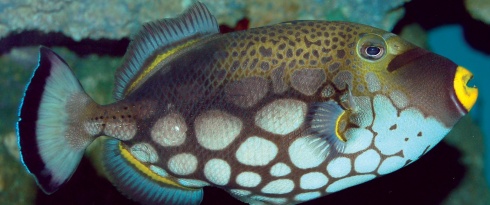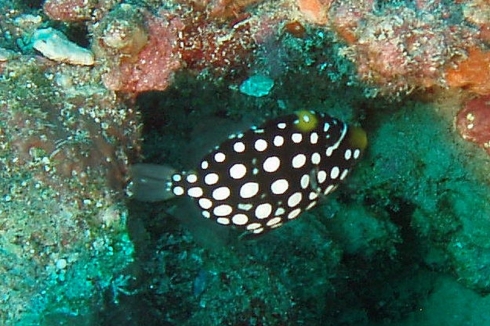
Halloween this year featured scary clowns…but I just realized that I forgot to include one of the best posts on this subject before October ended. This is Balistoides conspicillum, the clown triggerfish, one of the most beloved of all aquarium fishes because of its wild white spots and bright orange greasepaint mouth (along with sundry yellow/white stipples, squiggles, stripes and some translucent cornflower fins). I promised I would showcase some Tetraodontiformes (my favorite order of fish), and there could hardly be a showier fish in the ocean!

Don’t let this fish’s comic good looks deceive you though: it is not some oceangoing fop. Clown triggerfish live on coral reefs throughout the tropical Indo-Pacific (and maybe in the Caribbean part of Atlantic, during these days of irresponsible hobbyists) and the adult fish prefer a solitary life at the edge of the reef where it drops off into the endless blue of the ocean. The top of deep underwater cliffs is their favorite home, presumably so they can stare forbodingly into the depths like a melancholic hero from Romantic art. This means that clown triggerfish must cope with all of the denizens of the reef…and with pelagic outsiders who live by different standards than those of the bustling underwater “cities”.
Clown triggerfish stand up to other fish, even much larger ones, with an arsenal that includes strong muscles, nimble maneuverability, cleverness (they are reputed to be some of the smartest fish in the ocean), a locking “trigger” bone to make them hard to pry out of caves, and, oh yeah, a terrifying mouth filled with sharp rock-like teeth. Their diet of tunicates, spiny sea urchins, large arthropods (crabs and lobsters), and bivalve mollusks such as clams necessitates formidably strong jaw muscles. Apparently clown triggerfish can just bite right through lobster armor and clamshells. True to their common name, these fish sometimes become prankish with their owners and, at feeding time, they have been known to grunt comically and squirt water onto their favorite humans. If they like a person they can be fed by hand or even caressed, but it is a risky venture since, obviously, they can use their mouths for more than biting through clams.

Adult clown triggerfish grow to be half a meter in size and they can live for up to 20 years in captivity. When they spawn, the triggerfish dig a shallow nest in the coral rubble and lay eggs in it. Together the couple fiercely guards the eggs until the babies hatch, then all parties go their own ways. Juvenile clown triggerfish have a diamond shape and are completely covered in white spots (their other markings appear as they mature).


Leave a comment
Comments feed for this article